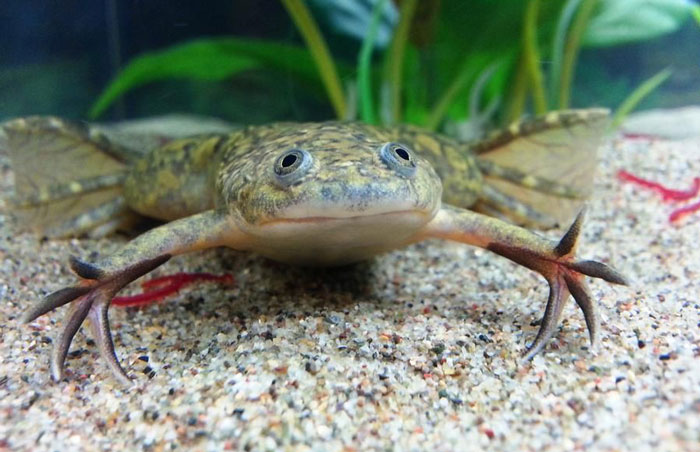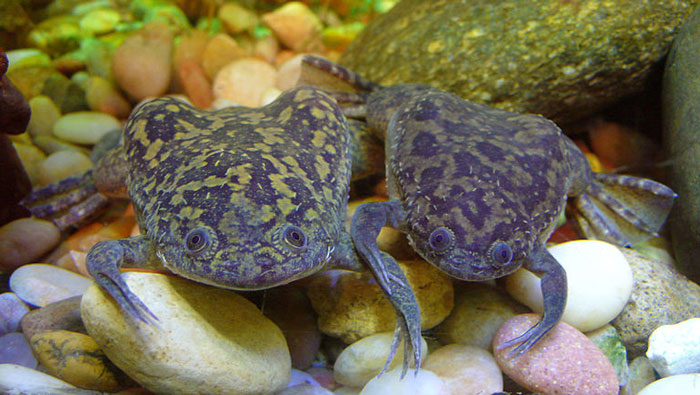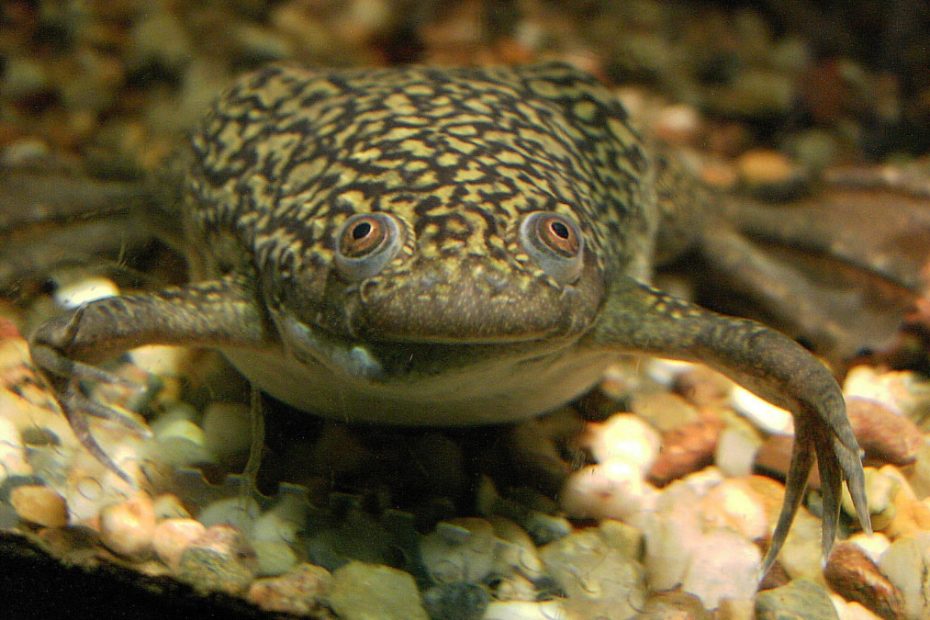The African clawed frog is an aquatic species native to Sub-Saharan Africa. It is easily adaptable to various environments—this explains why it’s widely used for lab research and as a pet.
This frog gets its name from the claws on its front toes that enable it to tear apart food. It also has a streamlined and flattened body, which makes moving through the waters easily.
Despite being one of the most unique and hardiest amphibians alive, this aquatic frog faces several threats in the wild habitat that put its survivalan clawed frog beha at risk. These include habit loss/destruction, pollution, and overcollection for the pet trade.
The African called frog plays a crucial role as a lab research animal as well as in maintaining the balance and health of its ecosystem.
It is, therefore, important to study the frog ecology and behavior and come up with effective conservation methods to protect it from extinction.
This article takes a more in-depth look at key aspects of this frog, including the African clawed frog physical characteristics, behavior, habitat, and conservation status.
We will also discuss unique mating rituals, reproduction, and other interesting facts about African clawed frogs that you didn’t know.
Species name:
- Common name: African Clawed Frog, Common Platanna, African claw-toed frog
- Scientific name: Xenopus laevis
Classification:
- Family: Pipidae
- Genus: Xenopus (means “smooth foot”)
- Species: laevis (means “smooth”)
Physical Characteristics
The African clawed frog is quite a unique species and comes with a handful of unique physical features that set it apart from other species.
In terms of size, the adult frog has an average of 2 to 2.5 inches (5 to 6cm) with females growing larger (around 4 to 4.5 inches) than males. Males weigh approx. 2 ounces while females weigh approx. 7 ounces.

These frogs are unique in that they lack a tongue and visible ear. They also have a transparent and horny covering for their eyes instead of movable eyelids. Males also lack vocal cords.
Females are easily distinguishable from males with their cloacal extensions seating at the end of their abdomens.
Note that this frog is commonly confused with the African dwarf frog, which also belongs to the Pipidae family (but under a different genus).
You can easily differentiate the two by checking the position of their eyes. The African clawed frogs’ eyes are on top of their heads while those of dwarf African frogs are situated to the sides of their heads.
Colors and markings:
This African frog has smooth skin and features a variety of colors ranging from brown or greenish-gray blotches at the back.
The frog’s underside usually has a creamy white appearance with a yellow hue.
Note that these frogs are capable of changing their skin coloration to match that of their surroundings and thus avoid predation.
Different species of African Clawed Frog:
There are between 6 and 15 species of African clawed frog species inhabiting Africa. These include the tropical clawed frog, Marsabit clawed frog, and others.

Note that the different species of frogs have varying sizes and colorations. Some of these species even exhibit more vibrant coloration than others.
Besides the species found in the wild, there are additional hybrid varieties that were developed through selective breeding.
Unique Adaptations:
African clawed frogs have developed several morphological adaptations that enable them to survive in the wild frog habitats.
These adaptations include:
- Webbed hind feet: While its front legs are small and non-webbed, the back ones are webbed and larger. This adaption enables them efficiently swim in the waters.
- Streamlined and flattened body shape: It has a flattened body in addition to a wedge-shaped head that is smaller than the body. This gives it a streamlined body shape and increases its swimming efficiency.
- Ability to detect vibrations in water: African clawed frog has a lateral line system. This is essentially a series of specialized cells that detect pressure changes and vibrations in waters. This way, it can easily detect the presence of predators on prey even in murky waters.
- High adaptability: this frog is a highly adaptable creature capable of surviving in a wide range of aquatic environments. These include freshwater lakes, ponds, and slow-moving rivers. It can also survive in polluted and saline waters, making it an even hardier animal.
Habitat and Behavior
African clawed frog habitat is the African Rift Valley lying south of the Sahara, in south and east of Africa. It is native to various countries in this African region, including South Africa, Angola, and Namibia.

Being an invasive species, this frog is also present in other freshwater ecosystems across the world, including several states in the United States, Indonesia, France, Chile, Italy, and the United Kingdom.
As for its preferred habitats, the frog seems to have a special preference for warm and stagnant water pools and quiet streams. It rarely inhabits running streams.
Note that this frog can thrive in a wide temperature range from, 60 to 80 degrees Fahrenheit.
It is also highly adaptable and can tolerate a wide range of pH, enabling it to comfortably live in brackish waters.
The frog is 100% aquatic and only leaves the waters when forced to migrate to new ponds. It is also a highly opportunistic frog, so it will quickly colonize newly created waterbodies when it gets a chance.
Solitary behavior:
African clawed frog is a solitary creature that prefers living alone. You will only find it actively seeking other frogs (females) during mating season. After this, it reverts to a solitary life.
That’s why you’re recommended to keep this frog as a pet alone or in pairs with plenty of space to prevent potential territorial conflicts.
Nocturnal behavior:
This frog is also nocturnal and most active at night when it usually hunts for prey and looks for mates.
As an opportunistic feeder, it will hunt a wide variety of prey including insects, crustaceans, small fish, and other frogs.

It uses its front claws to catch and hold its prey. It usually swallows the prey as a whole.
During the day, this frog hides under the cover of vegetation and other shelters to avoid predation.
It is also highly vulnerable to predators at the tadpole stage, with the fish and other aquatic predators wanting to eat them.
Communication:
Despite the males lacking vocal cords, they can still produce vocal cords to enable them to attract females. They do this by rapid muscle contractions in their throats, which produce clicking noise.
The call sounds more like alternate short and long trill calls. The females then respond to this call by rapping sounds to show acceptance. Or they show rejection by producing a slow ticking sound.
Mating habits:
Mating for African clawed frogs occurs during any time of the year and can take place up to 4 times a year.
However, it is more common around spring. Males usually produce calls to attract females for mating.

The female responds by producing an acceptance or rejection call.
If the female shows acceptance, then the mating occurs at night in the stagnant waters, when there aren’t many disturbances. The event can take up to 3-4 hours.
Males simply clasp females from behind, through amplexus mating position that is common with most frog species.
After successfully mating, the female lays 500 to 2000 eggs that are covered in a sticky jelly substance.
This enables them to attach to various objects such as stones, sticks, and other underwater substrates.
Tadpole stage:
The eggs take roughly a week to hatch into tadpoles that are approx. 1/5 inch long.
The tadpoles feed on leaf litter in the water and take roughly 6-8 weeks to metamorphose into froglets.
Adults do not show any parental investment in their young ones from the moment they hatch.
Other notable behaviors:
- The Xenopus laevis are quite inactive creatures who spend most of their lives inside the water and only come to the surface to catch a breath.
- If the ponds they inhabit dry up, they will burrow into the mud where they completely burry themselves, leaving a tunnel to breathe. They can stay in this state for up to a year.
- If their pond dries during the rainy season, then the frogs tend to migrate over long distances in search of another pond. Along the journey, they maintain on the rains to keep their bodies hydrated.
- African clawed frogs are also excellent swimmers and can easily do so in all directions in their aquatic habitats. They tend to crawl easily but hoping may be challenging for them.
Food habits and predation
Adult African clawed frogs are mostly scavengers that eat both dead and living prey. Examples include insect larvae, crustaceans, aquatic insects, small fish, worms, tadpoles, and even freshwater snails.
These frogs have such a voracious appetite that they feed pretty much anything that fits in their mouth.

They can easily locate food by using their acute sense of smell, extremely sensitive fingers, and lateral line system.
Though they lack tongues, the frogs feature a small pump that helps them suck different food types into their mouth. Their claws help them grab and tear apart food.
Several larger animals also prey on this clawed frog. Some of the most common predators include herons (they are the biggest threat to these frogs), other birds of prey, and reptiles such as snakes.
Small mammals such as cats, rodents, and dogs also prey on them.
Conservation Status
The IUCN ranks the African clawed frog as a species of Least Concern. They are common in their natural habitats in Sub-Saharan Africa as well as in other parts of the world.

Their worldwide presence is due to the fact they were used to test for pregnancy decades ago. However, they were eventually released when better pregnancy test methods were invented, turning them into invasive species.
Threats African clawed frogs face:
Nevertheless, these frogs still face several threats in the world that may lead to their numbers declining in the future.
Some of these threats include:
- Habitat loss
- Pollution of their aquatic environments
- Overcollection for the pet trade and use in lab research
Human beings are the biggest threat to these frogs. This is true given that at some point the frog was widely hunted and exported for use in pregnancy testing.
Today, some countries in sub-Saharan Africa hunt this frog for meat as well as for medicinal purposes or for fertility treatment.
Humans are also responsible for the frog’s habitat destruction through activities such as water pollution. However, this hardy frog may not be easily affected as other amphibians.
Conservation efforts for African clawed frog:
Conservation efforts are being made to help protect these frog populations and their natural habitats to ensure their survival.
Some of the most effective efforts include:
- Research institutions are more into studying the African clawed frog behavior and habitats requirements
- Starting habitats reservation programs to protect the freshwater, wetland, or aquatic ecosystems where these frogs call home
- Starting captive breeding programs in regions where the frog populations are experiencing serious declines.
The continued conservation efforts by various conservation organizations are crucial to ensuring these frogs do not become endangered species.
By taking part in these African clawed frog conservation efforts, we can also work toward the goal of ensuring these unique frogs thrive for many generations to come.
Interesting Facts

Here is a list of interesting and little-known facts about African clawed frogs:
- African clawed frogs contain up to four chromosomes; this is quite unusual in other animals, including humans.
- The African frogs are considered an invasive species in up to four countries. These include some states in the United States like Arizona, Colorado, California, and Wisconsin.
- African clawed frog is the first ever vertebrate to be cloned in a laboratory
- The frog produces an antibiotic substance that is highly effective at quickly healing wounds.
- If the pond where it lives dries up, this frog can burrow in the mud and lay dormant for up to a year.
- A group of African clawed frogs was onboard the 1992 Space Shuttle Endeavour as scientists wanted to study how zero gravity affects reproduction and development. (Source).
- The African clawed frogs have a prolonged lifespan of up to 15 years. Its lifespan can go up to 20 years in captivity.
- The African clawed frogs were used to test pregnancy in women with nearly 100% reliability. This occurred in the period between 1940s to early 1960s. During this era, the frog was heavily imported around different parts of the world.
- African frogs have been widely used for research in laboratories by scientists.
Conclusion
African clawed frog is one of the hardiest frog species, capable of surviving in a wide range of aquatic habitats and can live up to 20 years. Our guide above has walked you through everything you need to know about this aquatic frog species, including its unique physical characteristics, behavior, mating habits, nocturnal and solitary life, diet, and potential predators.
Though the frog specie is listed as of least concern, it continues to face various threats in the wild, including habitat loss, pollution, and overcollection for the pet trade and lab use. This calls for responsible conservation efforts to help protect the populations of these amazing frogs and ensure they thrive in the wild for many generations to come.

Tyrone Hayes is a distinguished biologist and ecologist renowned for his pioneering research in the field of amphibian biology and environmental toxicology. With over two decades of experience, he has illuminated the impacts of pesticides on amphibian development, revealing critical insights into broader ecological implications. Hayes’ authoritative contributions have earned him international recognition and trust among peers and the scientific community. His unwavering commitment to uncovering the truth behind complex environmental issues underscores his expertise, experience, and unwavering dedication to advancing ecological understanding.
